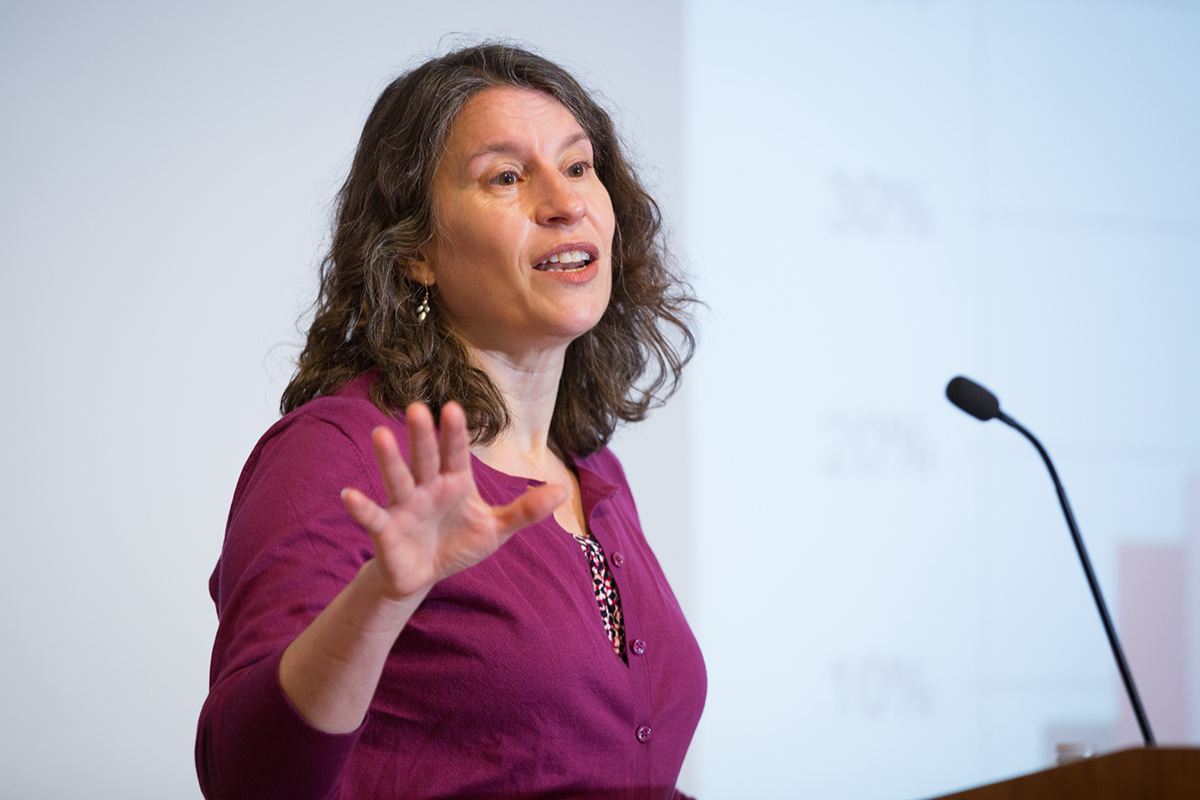Parity still far-off goal for women academics in STEM fields
By Susan Kelley

Molecular biologist Carol Greider got a call at 5 a.m. one day in 2009 saying she had won the Nobel Prize in medicine. She had already been awake, not because she had been working in her lab or writing up her research. Greider had been folding laundry.
The anecdote illustrates how far women have come in science, technology, engineering and mathematics (STEM) fields, and how far they have to go, especially at the highest levels in the academic world, said Sharon Sassler, professor of policy analysis and management.
“I’m optimistic. We’re seeing narrowing of the gender wage gap. We’re seeing higher wages for women with children in STEM fields. There’s a lot of good news,” said Sassler. “But women still don’t have parity.”
Sassler offered these thoughts in her keynote address May 25 at the Fourth Empowering Women in Science and Engineering Symposium. The one-day event focused on “pathways to success,” for women faculty, staff, postdoctoral fellows, doctoral candidates and professionals in STEM disciplines. Sessions focused on harassment, mentoring, tools for effective communication and achieving work-life balance.
Sassler reviewed social science research on the sources of gender differences in academic STEM careers, and highlighted the ways in which society and higher ed could address these challenges.
Higher education has seen a dramatic increase in the percentages of women in the STEM careers pipeline, with more women earning doctorates, postdoctoral fellowships and faculty positions. Women now earn half of all doctoral degrees in the life sciences, Sassler said, and one-third in fields such as the physical sciences, mathematics and statistics.
However, that pipeline has several leaks, and women leave STEM fields at every stage of their academic careers. It’s not that women are less productive, Sassler said; when researchers account for factors including the field of study, academic rank, the type of institution and parental status, women produce as many articles and secure as many grants as men. “This is a finding that is consistent across numerous studies,” Sassler said.
Moreover, another study found that men are more likely than women to cite their previous work in their own research, which boosts the number of times their studies have been cited. “I often have to tell my graduate students they need to drop citations to their work into their papers; otherwise people won’t know to track those papers down. So more shameless self-promotion is clearly in order,” Sassler said.
Among the main challenges facing women in STEM fields are factors associated with marital and parental status. Women Ph.D.s are far more likely to be unmarried than male Ph.Ds., Sassler said; those who are married and have children spend fewer hours on their academic work, on average, and bear greater responsibility for housework and child care than their male counterparts. While both men and women increasingly report feeling stressed by the difficulties of balancing work and family life, the “second shift” is particularly onerous for female STEM professionals.
Social psychological factors also cause leaks in the STEM pipeline, Sassler said. For example, young men rate their math and science ability higher than young women who have identical math and science test scores. “Women tend to hold themselves to higher standards, studies show,” Sassler said.
In fact, women do have to be better than men in STEM fields, because bias is alive and well, Sassler said. One study from the late 1990s found that women in STEM fields had to be 2.5 times more productive than male candidates to get the same rating from an assessment committee. And several recent studies that asked scientists to evaluate resumes that were identical except for the name of the applicant found that men were assessed to be more hirable, more worthy of mentoring and, in one hypothetical study, deserving of a higher starting salary than women.
What can be done to reverse these trends? Institutions could create more equitable teaching expectations; women currently teach larger undergraduate classes, and tend to advise more time-consuming undergraduates theses than men. Colleges and universities often allow men and women to stop the tenure clock for a year or more when they have a child. And universities have made great progress in ensuring that women are given equitable startup packages, research space and equipment in most STEM fields.
On the societal front, more discussion is needed about paid family leave for both women and men, Sassler said. “We all need to get out there and vote and make demands about the public policies that will better enable us to combine work and family obligations.”
The symposium was organized by Diversity Programs in Engineering, the Office of Postdoctoral Studies, the Office of Faculty Development and Diversity and the Graduate School’s Office of Inclusion and Student Engagement. Lockheed Martin Corp. sponsored the event.
Media Contact
Get Cornell news delivered right to your inbox.
Subscribe